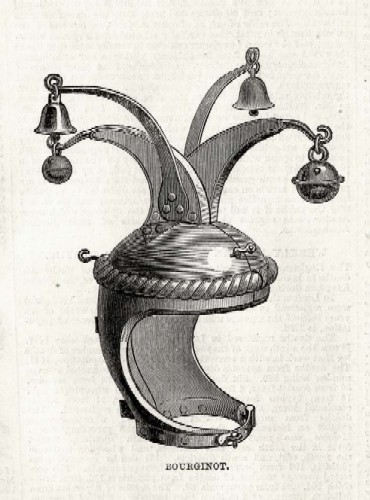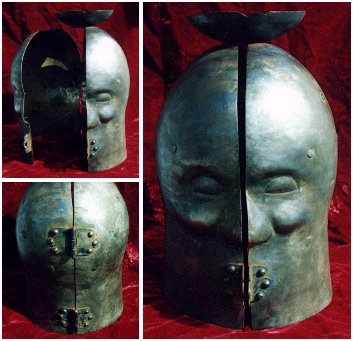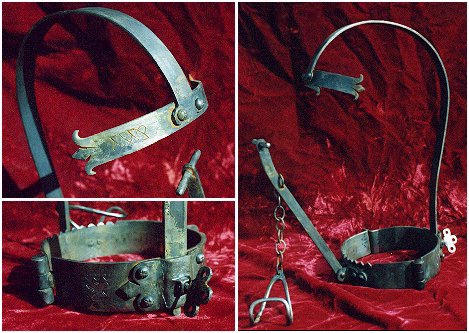
The Illustratated London News presented a series of engravings during 1869 of the ancient arms and armour from the Meyrick Collection at South Kensington. Amoung the various pieces published was this odd looking helmet. Is it possible that Jestering could have been confused with Jousting in South Kensington?
 Attachment: 51.64 KB
Attachment: 51.64 KB


It is very unlikely that this was used for jousting, as it has no faceplate. But it's conceivable that a jester or fool could have worn it during some kind of tournament or armourial pageant in a non-combative position. I have read - and this could be totally mistaken, but anyway - that the famous horned helmet given to Henry VIII by Maximilian was actually intended for Henry's fool, Will Somers. There seems to be some precedent for decorative helmets being worn by jesters.
See this great post by Nathan Robinson where a very interesting helm is shown:
[ Linked Image ]
Click for detailed version
See this great post by Nathan Robinson where a very interesting helm is shown:
[ Linked Image ]
Click for detailed version
What an intriguing item!
As shown in the attached image from:
British costume : a complete history of the dress of the inhabitants of the British islands (1846)
Author: Planché, James Robinson, 1796-1880
Subject: Costume -- Great Britain; Great Britain -- Social life and customs
Publisher: London : M.A. Nattali
a bourginot is much more enclosed and protective than the image of the item in question.
My best guess would be a bourginot for training in the joust. A steady head and body even at a gallop was neccessary while approaching the opponent. Bells on the head would audibly indicate to the wearer and the trainer as to the stability of the approach.
 Attachment: 169.41 KB
Attachment: 169.41 KB
[ Download ]
As shown in the attached image from:
British costume : a complete history of the dress of the inhabitants of the British islands (1846)
Author: Planché, James Robinson, 1796-1880
Subject: Costume -- Great Britain; Great Britain -- Social life and customs
Publisher: London : M.A. Nattali
a bourginot is much more enclosed and protective than the image of the item in question.
My best guess would be a bourginot for training in the joust. A steady head and body even at a gallop was neccessary while approaching the opponent. Bells on the head would audibly indicate to the wearer and the trainer as to the stability of the approach.
[ Download ]
Not all burgonets had the level of enclosure of that attached image; the burgonet shown there is an example of a "close burgonet", a hybrid of burgonet and close helmet which seems to have been most popular during the first half of the 1600s. Prior to that, burgonets were often open-faced. A falling buffe could be added to protect the face, but was frequently omitted.
| Allen Foster wrote: |
| The Illustratated London News presented a series of engravings during 1869 of the ancient arms and armour from the Meyrick Collection at South Kensington. Amoung the various pieces published was this odd looking helmet. Is it possible that Jestering could have been confused with Jousting in South Kensington? |
This may be totally off the wall, but I will throw it out for consideration. I have seen iron headgear with bells that was used on U.S. southern plantations prior to the U.S. Civil War. The head gear was made of iron and designed to be locked and to jingle to announce a slave's presence. The idea was to punish and prevent a slave from running away. I cannot see the image with enough detail to see if the helmet can be locked in place.
Since there is nothing new under the sun, I think the idea of the iron helmet with bells as a form of punishment is probably much older than the one I saw in the museum about Louisiana plantations.
Public Punishment and humiliation reached new ceative heights in the middle ages along with torture and witch trials (If she floats she's guilty-or weighs the same as a duck; if she sinks, she's innocent)
These were replicas made from originals by Rob Valentine
 Attachment: 33.03 KB
Attachment: 33.03 KB

Boiling Oil Mask
 Attachment: 59.04 KB
Attachment: 59.04 KB

Iron Restraint
These were replicas made from originals by Rob Valentine

Boiling Oil Mask

Iron Restraint
And isn't it possible, simply, that the Illustrated London News got punk'd by some sort of hoax ?
Allen, your first question is valid. It seems to me that all legislative bodies , be they Parliaments, House of Representatives, various Senates, all continue to confuse both terms. If you sit down and take the time to listen to democracy at work, expecting jousting, you end up mostly with jestering, with tones borrowed from jousting, and three quarters of the sitting parliamentarians, or senators, or representatives should be wearing the headgear you have shown us... the other quarter seems to manage to sleep through it all... Then again, as most mid-level officers would attest to, and all non-coms, that head gear might have been especially made for a four star general... or Marshall in medieval terms ...
Cheers,
JC
Cheers,
JC
| Jean-Carle Hudon wrote: |
| Allen, your first question is valid. It seems to me that all legislative bodies , be they Parliaments, House of Representatives, various Senates, all continue to confuse both terms. If you sit down and take the time to listen to democracy at work, expecting jousting, you end up mostly with jestering, with tones borrowed from jousting, and three quarters of the sitting parliamentarians, or senators, or representatives should be wearing the headgear you have shown us... the other quarter seems to manage to sleep through it all... Then again, as most mid-level officers would attest to, and all non-coms, that head gear might have been especially made for a four star general... or Marshall in medieval terms ...
Cheers, JC |
Ah, I see. So the helm could have served as a display of plumage for some South Kensington courtier who fancied himself as a Jouster when in fact he was really a Jester? Both fascinating and Ironic.
Page 1 of 1
You cannot post new topics in this forumYou cannot reply to topics in this forum
You cannot edit your posts in this forum
You cannot delete your posts in this forum
You cannot vote in polls in this forum
You cannot attach files in this forum
You can download files in this forum
All contents © Copyright 2003-2006 myArmoury.com — All rights reserved
Discussion forums powered by phpBB © The phpBB Group
Switch to the Full-featured Version of the forum
Discussion forums powered by phpBB © The phpBB Group
Switch to the Full-featured Version of the forum